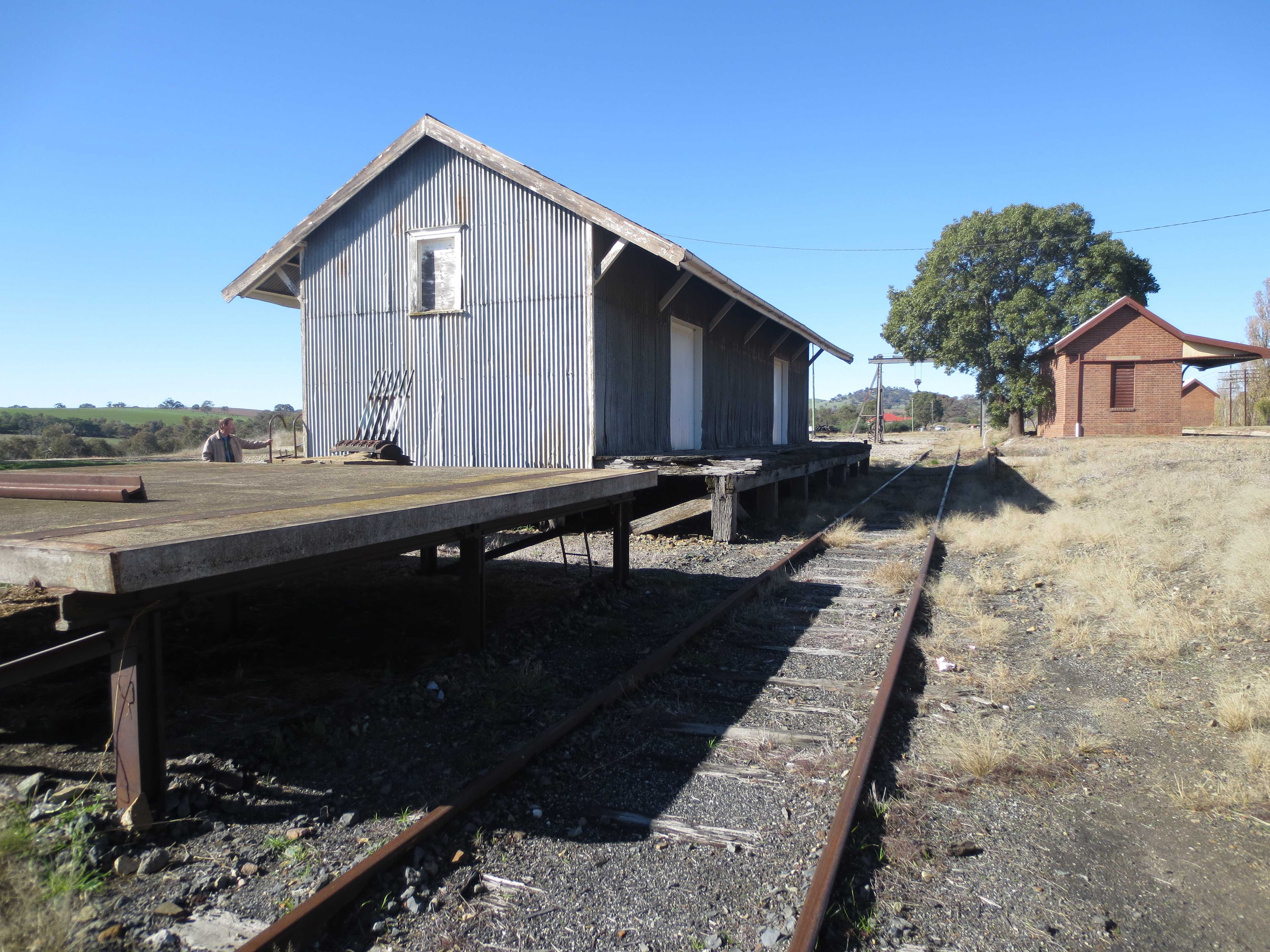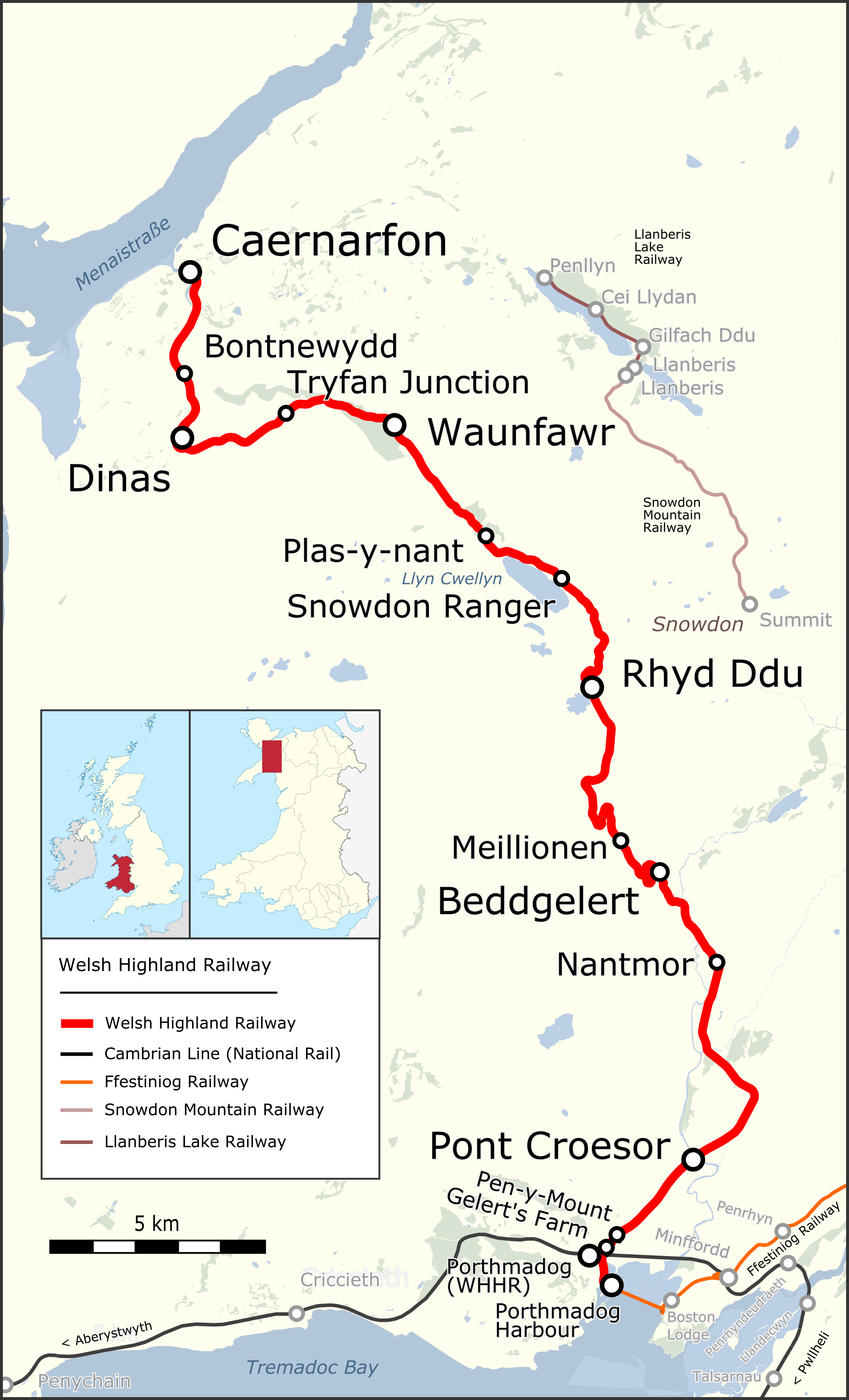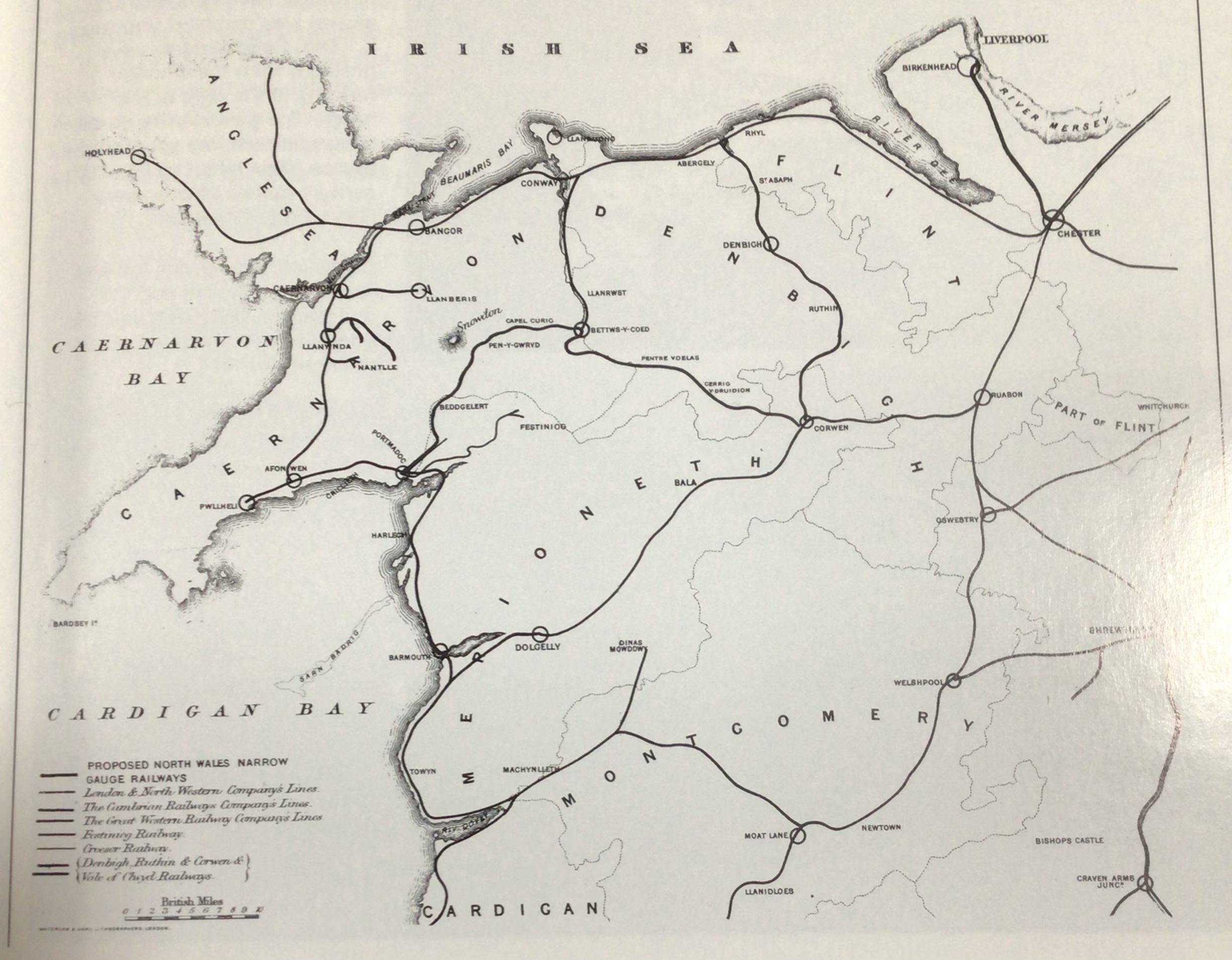|
Dinas, Gwynedd
Dinas is a large hamlet near Bontnewydd, Caernarfon, in Gwynedd, north-west Wales. It is in the ancient parish and modern community of Llanwnda and is served by the parish church of St. Gwyndaf in Llanwnda village, which is about a quarter of a mile to the south. The hamlet developed with the opening of the turnpike Toll roads from Caernarfon first to Pwllheli in 1805, then to Porthmadog in 1810. Two coaching inns were built to serve the roads, Y Mount, which is now an Indian restaurant and Tafarn Hen, which is now a private residence. The Carnarvonshire Railway was built in 1866 on the route of the horse drawn Nantlle Railway. The building in 1878 of the North Wales Narrow Gauge Railways (later part of the Welsh Highland Railway) resulted in the opening of Dinas Junction station complete with slate transshipment facilities, which brought the construction of houses for the railway staff. The 20th century saw the development of suburban housing for Caernarfon. The present Dina ... [...More Info...] [...Related Items...] OR: [Wikipedia] [Google] [Baidu] |
Llanwnda, Gwynedd
Llanwnda is a village, community and electoral ward in Gwynedd, Wales. The community has a population of 1,994 as taken at the 2011 Census. It is situated about 3 miles to the south of Caernarfon, and 5 miles south-west of Llanrug. According to the 2011 Census, 81.6% of the population were Welsh speakers. The image on the right is of Glanrhyd, Llanwnda, not the village of Llanwnda less than a mile to the south. The community includes the slate mining villages of Rhosgadfan Rhosgadfan is a Wales, Welsh village in the county of Gwynedd, formerly in the historic county of Caernarfonshire, and in the community of Llanwnda, Gwynedd, Llanwnda. It is notable as the birthplace of Kate Roberts (author), Kate Roberts, one o ... and Rhostryfan. References * External links www.geograph.co.uk : photos of Llanwnda and surrounding area Villages in Gwynedd Communities in Gwynedd {{gwynedd-geo-stub ... [...More Info...] [...Related Items...] OR: [Wikipedia] [Google] [Baidu] |
Coaching Inn
The coaching inn (also coaching house or staging inn) was a vital part of Europe's inland transport infrastructure until the development of the railway, providing a resting point ( layover) for people and horses. The inn served the needs of travellers, for food, drink, and rest. The attached stables, staffed by hostlers, cared for the horses, including changing a tired team for a fresh one. Coaching inns were used by private travellers in their coaches, the public riding stagecoaches between one town and another, and (in England at least) the mail coach. Just as with roadhouses in other countries, although many survive, and some still offer overnight accommodation, in general coaching inns have lost their original function and now operate as ordinary pubs. Coaching inns stabled teams of horses for stagecoaches and mail coaches and replaced tired teams with fresh teams. In America, stage stations performed these functions. Traditionally English coaching inns were seven miles a ... [...More Info...] [...Related Items...] OR: [Wikipedia] [Google] [Baidu] |
Pont Croesor
Pont Croesor is a railway halt in Wales, on the Welsh Highland Railway, which runs through the Snowdonia National Park from Caernarfon to Porthmadog. It is located on the section between the stations of and . Originally, as part of the Croesor Tramway, there was a siding at this location but no station. When the WHR was initially built in 1923 a small halt was provided; however, this closed with the railway in 1936 and all trace of this was removed when the line was lifted. The line from Pont Croesor to has been connected since early 2009, being available for stock transfer purposes. The station was officially opened on 26 May 2010 and was the WHR's temporary terminus, having previously opened to passengers on 22 May 2010. The previous terminus at is now closed. It opened to timetabled passenger services on 8 January 2011. When the station opened there was a full-length platform on the west side of the loop only, but with the commencement of through services in both d ... [...More Info...] [...Related Items...] OR: [Wikipedia] [Google] [Baidu] |
Beddgelert
Beddgelert () is a village and community in the Snowdonia area of Gwynedd, Wales. The population of the community taken at the 2011 census was 455, and includes Nantmor and Nant Gwynant. It is reputed to be named after the legendary hound Gelert. The community is large and sparsely populated and covers 86 square kilometres. Location The village stands in a valley at the confluence of the River Glaslyn and the River Colwyn. Just above the confluence of the rivers, in the centre of the village, is an old stone bridge with two arches. The River Gwynant also exists in the area, coinciding with the River Colwyn under what locals know as ‘Pont Bren’, creating the River Glaslyn. Many of the houses and hotels are built of local dark stone. To the west is Moel Hebog and its neighbours to the north and a series of hills rising to the top of Snowdon. A lane of the A4085 between Caernarfon (13 miles north) and Porthmadog (8 miles south) runs through the village. The outdoor e ... [...More Info...] [...Related Items...] OR: [Wikipedia] [Google] [Baidu] |
Waunfawr
Waunfawr (''gwaun'' + ''mawr'', en, large moorland/meadow) is a village and community, SE of Caernarfon, near the Snowdonia National Park, Gwynedd, in Wales. Description Waunfawr is in the Gwyrfai valley, on the A4085 road from Caernarfon to Beddgelert. Waunfawr railway station on the Welsh Highland Railway between Caernarfon and Porthmadog adjoins the Snowdonia Park Brewpub and Campsite at the southern end of the village. The brewpub is a recent winner of the Campaign for Real Ale award for a number of its beers and voted best pub in the region for 2012; and has also won the CAMRA Gwynedd a Mon Pub of the Year, in 2012,13,14 & 15. The name Waunfawr was previously spelled ''Waenfawr'', a garbled version corrected by common consent in 1994 consistent with the aims of the Welsh Language Society to maintain the Welsh language in its proper form throughout public signage and usage. The community had a population of 1,427 at the 2011 census. According to the United Kingdom Censu ... [...More Info...] [...Related Items...] OR: [Wikipedia] [Google] [Baidu] |
Dinas Railway Station
Dinas is a station on the narrow gauge Welsh Highland Railway, which was built in 1877 as the North Wales Narrow Gauge Railways Moel Tryfan Undertaking to carry dressed slate for trans-shipment to the LNWR. Passenger services ceased on 26 September 1936 until which time Dinas had been a joint station, known as Dinas Junction with the LNWR and later the LMS. In 1951, British Railways closed their part of the station but the line through the station remained open until the line from Caernarvon to Afon Wen was closed in 1964. The trackbed was subsequently developed as the Lôn Eifion tourist cycle route. When the station was reopened on 11 October 1997, it was as the southern temporary terminus of the extended and soon to be restored Welsh Highland Railway from . Following reconstruction of the trackbed, the line was reopened on its original trackbed, in stages; on 7 August 2000 to Waunfawr; in 2003 to Rhyd Ddu; through the Aberglaslyn Pass to Beddgelert and Hafod-y-lyn in 2009 ... [...More Info...] [...Related Items...] OR: [Wikipedia] [Google] [Baidu] |
Suburban
A suburb (more broadly suburban area) is an area within a metropolitan area, which may include commercial and mixed-use, that is primarily a residential area. A suburb can exist either as part of a larger city/urban area or as a separate political entity. The name describes an area which is not as densely populated as an inner city, yet more densely populated than a rural area in the countryside. In many metropolitan areas, suburbs exist as separate residential communities within commuting distance of a city (cf "bedroom suburb".) Suburbs can have their own political or legal jurisdiction, especially in the United States, but this is not always the case, especially in the United Kingdom, where most suburbs are located within the administrative boundaries of cities. In most English-speaking countries, suburban areas are defined in contrast to central or inner city areas, but in Australian English and South African English, ''suburb'' has become largely synonymous with what ... [...More Info...] [...Related Items...] OR: [Wikipedia] [Google] [Baidu] |
Transshipment
Transshipment, trans-shipment or transhipment is the shipment of goods or containers to an intermediate destination, then to another destination. One possible reason for transshipment is to change the means of transport during the journey (e.g., from ship transport to road transport), known as transloading. Another reason is to combine small shipments into a large shipment (consolidation), or the opposite: dividing a large shipment into smaller shipments (deconsolidation). Transshipment usually takes place in transport hubs. Much international transshipment also takes place in designated customs areas, thus avoiding the need for customs checks or duties, otherwise a major hindrance for efficient transport. An item handled (from the shipper's point of view) as a single movement is not generally considered transshipped, even if it changes from one mode of transport to another at several points. Previously, it was often not distinguished from transloading, since each leg of such ... [...More Info...] [...Related Items...] OR: [Wikipedia] [Google] [Baidu] |
Slate
Slate is a fine-grained, foliated, homogeneous metamorphic rock derived from an original shale-type sedimentary rock composed of clay or volcanic ash through low-grade regional metamorphism. It is the finest grained foliated metamorphic rock. Foliation may not correspond to the original sedimentary layering, but instead is in planes perpendicular to the direction of metamorphic compression. The foliation in slate is called "slaty cleavage". It is caused by strong compression causing fine grained clay flakes to regrow in planes perpendicular to the compression. When expertly "cut" by striking parallel to the foliation, with a specialized tool in the quarry, many slates will display a property called fissility, forming smooth flat sheets of stone which have long been used for roofing, floor tiles, and other purposes. Slate is frequently grey in color, especially when seen, en masse, covering roofs. However, slate occurs in a variety of colors even from a single locality; for ex ... [...More Info...] [...Related Items...] OR: [Wikipedia] [Google] [Baidu] |
Welsh Highland Railway
The Welsh Highland Railway (WHR) or Rheilffordd Eryri is a long, restored narrow gauge heritage railway in the Welsh county of Gwynedd, operating from Caernarfon to Porthmadog, and passing through a number of popular tourist destinations including Beddgelert and the Aberglaslyn Pass. At Porthmadog it connects with the Ffestiniog Railway and to the short Welsh Highland Heritage Railway. In Porthmadog it uses the United Kingdom's only mixed gauge flat rail crossing. The restoration, which had the civil engineering mainly built by contractors and the track mainly built by volunteers, received a number of awards. Originally running from , near Caernarfon, to ,Boyd (1972), pages=283 the current line includes an additional section from Dinas to Caernarfon. The original line also had a branch to and the slate quarries around Moel Tryfan, which has not been restored. (This branch forms a footpath "rail trail", the lower section of which has been resurfaced and supplied with heri ... [...More Info...] [...Related Items...] OR: [Wikipedia] [Google] [Baidu] |
North Wales Narrow Gauge Railways
The North Wales Narrow Gauge Railways (NWNGR) was a railway company that planned to build a number of inter-connected narrow-gauge railways across North Wales. The first two of these lines - jointly known as the "Moel Tryfan Undertaking" - were authorised by Act of Parliament 1872 and were built and opened in the 1870s. The original main line ran from Dinas Junction to Bryngwyn and opened in 1877. The second line was a branch from Tryfan Junction to South Snowdon, though shortly after opening, the company designated the Tryfan Junction to Bryngwyn section as the branch, and the Dinas Junction to South Snowdon section as the main line. Routes built The company completed construction of two lines, The first, opened in 1877, was approximately long, running south-east from a junction with the London and North Western Railway's Caernarfon to Afon Wen branch at , to . There were intermediate stations at and . From Bryngwyn, a shallow incline Incline, inclined, inclining, or in ... [...More Info...] [...Related Items...] OR: [Wikipedia] [Google] [Baidu] |
Nantlle Railway
The Nantlle Railway (or Nantlle Tramway) was a Welsh narrow gauge railway. It was built to carry slate from several slate quarries across the Nantlle Valley to the harbour at Caernarfon for export by sea. The line provided a passenger service between Caernarfon and Talysarn from 1856 to 1865. It was the first public railway to be operated in North Wales. A tramway linking the Nantlle slate quarries to Caernarfon was proposed in the 1810s. The Nantlle Railway was authorised by an Act of Parliament in May 1825, and the company began construction of the railway. The line was designed and constructed by George Stephenson and his son, Robert. The line opened in 1828 and was operated using horses. [George Stephenson and his BROTHER Robert, not his son Robert; viz. letters from Robert snr. to his brother in Liverpool quoted by Boyd (N.Caerns Vol.I p.15>). These letters in the Phillimore collection and the Institution of Mechanical Engineers.] During the 1860s and 1870s, a port ... [...More Info...] [...Related Items...] OR: [Wikipedia] [Google] [Baidu] |






.jpg)